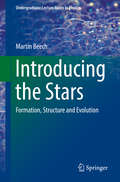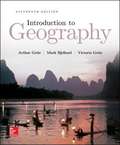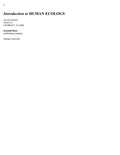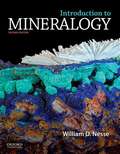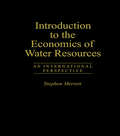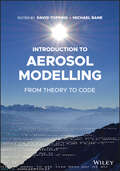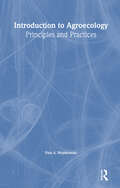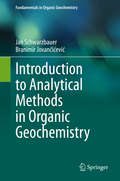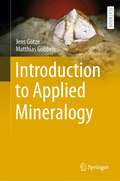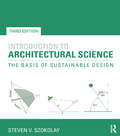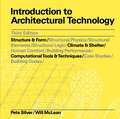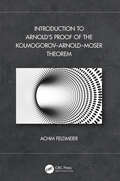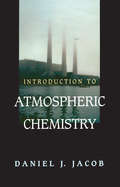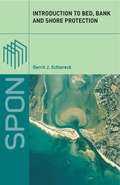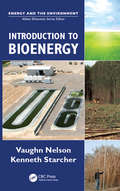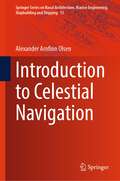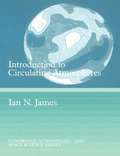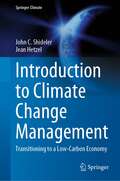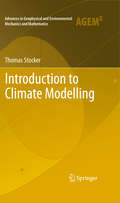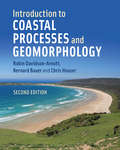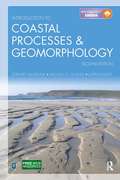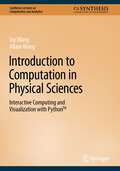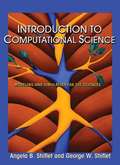- Table View
- List View
Introducing the Stars: Formation, Structure and Evolution (Undergraduate Lecture Notes in Physics)
by Martin BeechThis textbook introduces the reader to the basic concepts and equations that describe stellar structure. Various approximation techniques are used to solve equations, and an intuitive rather than rigorous approach is employed to interpret the properties of the stars. The book provides step-by-step instructions, helpful exercises and relevant historical lessons to familiarize students with key concepts and mathematical theories.Based upon a series of one-semester (12 weeks) elective undergraduate courses offered at the University of Regina, this book is intended for students who are interested in seeing how basic calculus and introductory physics can be applied to the understanding of the stars from their formation to their death. The text provides an intermediate stepping stone between lower-level undergraduate classes and more specialized postgraduate texts on the subject of stellar structure.
Introduction To Geography
by Victoria Getis Mark BjellandGetis Introduction to Geography is written to clearly and concisely convey the nature of the field of geography, its intellectual challenges, and the logical interconnections of its parts. Even if students take no further work in geography, they will have come into contact with the richness and breadth of Geography and have new insights and understandings for their present and future roles as informed adults. This new edition provides students content and scope of the subfields of geography, emphasize its unifying themes, and provide the foundation for further work in their areas of interest. A useful textbook must be flexible enough in its organization to permit an instructor to adapt it to the time and subject matter constraints of a particular course. Although Getis Introduction to Geography is designed with a one-quarter or one-semester course in mind, this text may be used in a full-year introduction to geography when employed as a point of departure for special topics and amplifications introduced by the instructor or when supplemented by additional readings and class projects.
Introduction To Human Ecology
by George F. ClarkIntroduction to Human Ecology is a reader designed to accompany the course of the same name at Rutgers University and similar courses offered elsewhere. It provides articles illustrating basic human ecological concepts such as ethnocentrism, the commons, and cost-benefit analysis, offers a sample of environmental issues and problems, and does so using a diverse array of culture, disciplines and viewpoints. It is designed to give foundational knowledge, some new tools with which to think critically, and to stimulate thought via differing perspectives.
Introduction To Mineralogy
by William NesseThe second edition of Introduction to Mineralogy follows the highly successful first edition, which become an overnight market leader. Introduction to Mineralogy consolidates much of the material now covered in traditional mineralogy and optical mineralogy courses and focuses on describing minerals within their geologic context. It presents the important traditional content of mineralogy including crystallography, chemical bonding, controls on mineral structure, mineral stability, and crystal growth to provide a foundation that enables students to understand the nature and occurrence of minerals. Physical, optical, and X-ray powder diffraction techniques of mineral study are described in detail, and common chemical analytical methods are outlined as well. Detailed descriptions of over 100 common minerals are provided, and the geologic context within which these minerals occur is emphasized. Appendices provide tables and diagrams to help students with mineral identification, using both physical and optical properties. Numerous line drawings, photographs, and photomicrographs help make complex concepts understandable. Introduction to Mineralogy is available with Daniel Schulze's An Atlas of Minerals in Thin Section for a nominal additional fee. NEW TO THIS EDITION: -New 2-color design to clarify information hierarchy and presentation -Expanded selection of mineral photos -Improved presentation of physical properties of minerals in chapter 1 -Updated mineral descriptions -New coverage of minerals and health
Introduction To The Economics Of Water Resources: An International Perspective
by Stephen MerrettFirst published in 1997. Routledge is an imprint of Taylor & Francis, an informa company.
Introduction to Aerosol Modelling: From Theory to Code
by David ToppingINTRODUCTION TO AEROSOL MODELLING Introduction to Aerosol Modelling: From Theory to Code An aerosol particle is defined as a solid or liquid particle suspended in a carrier gas. Whilst we often treat scientific challenges in a siloed way, aerosol particles are of interest across many disciplines. For example, atmospheric aerosol particles are key determinants of air quality and climate change. Knowledge of aerosol physics and generation mechanisms is key to efficient fuel delivery and drug delivery to the lungs. Likewise, various manufacturing processes require optimal generation, delivery and removal of aerosol particles in a range of conditions. There is a natural tendency for the aerosol scientist to therefore work at the interface of the traditional academic subjects of physics, chemistry, biology, mathematics and computing. The impacts that aerosol particles have are linked to their evolving chemical and physical characteristics. Likewise, the chemical and physical characteristic of aerosol particles reflect their sources and subsequent processes they have been subject to. Computational models are not only essential for constructing evidence-based understanding of important aerosol processes, but also to predict change and impact. Whilst existing textbooks provide an overview of theoretical frameworks on which aerosol models are based, there is a significant gap in reference material that provide training in translating theory into code. The purpose of this book is to provide readers with exactly that. In following the content provided in this book, you will be able to reproduce models of key processes that can either be used in isolation or brought together to construct a demonstrator 0D box-model of a coupled gaseous-particulate system. You may be reading this book as an undergraduate, postgraduate, seasoned researcher in the private/public sector or as someone who wishes to better understand the pathways to aerosol model development. Wherever you position yourself, it is hoped that the tools you will learn through this book will provide you with the basis to develop your own platforms and to ensure the next generation of aerosol modellers are equipped with foundational skills to address future challenges in aerosol science.
Introduction to Agroecology: Principles and Practices
by Paul WojtkowskiA crucial reference/textbook that provides a wide spectrum of information in one easily understandable sourceThe essence of agroecology lies in harnessing and harmonizing the forces of nature for productive purpose. Introduction to Agroecology: Principles and Practices comprehensively explains how this is done, providing a detailed, inclusive look at the underlying theories, concepts, and practices. This allows the reader to explore the full range of possibilities of the nature/agricultural interface and to view agroecology in its entirety, all while providing a clear understanding of the inherent complexity. Productive threats to cropping such as soil depletion, drought, plant-eating insects, heat and cold, weeds, and small and large animals are discussed in depth—with preventative strategies for each—all together in one easy-to-use book.This unique introductory reference source is not only aimed at the novice, but also the more advanced student. In a departure from the norm for introductory material, extensive endnotes elaborate upon the basic information, presenting a full look at the arguments and controversies within the field. The endnotes include over 500 citations, offering a broad window that encompasses ecology, sociology, conservation and environmental studies, and several other fields. The text also contains numerous charts, figures, and tables to clarify data and ideas.Introduction to Agroecology reviews and discusses: agroecological goals, such as profit, quality of life, and minimum disturbance of the natural ecosystem spatial principles, with resource concepts such as capture, production, balance, and biodiversity planting densities, ratios, and spatial patterns facilitation of nutrient and water capture-transfer ecosystem governance certainty-sustainability threats, such as drought, wind, flood, temperature, and fire the use of fences, repellant plants, fauna, and other means to stave off large animal threats basic insect countermeasures agrotechnologies subdivision, scaling, design packages, agrobiodiversity adjustments, and mimicry monocultures seasonal intercropping facilitative and productive agroforestry the use of reservoirs, corridors, wind structures, riparian buffers, firebreaks, and other means as auxiliary systems land modification social and community agroecology core approaches to alternative agriculture, including genetic, microbial, varietal, rotational, and others agroecosystem design many, many more topics Introduction to Agroecology is a unique and accessible reference for those who seek a deeper understanding of the mechanisms and practices that provide a solid foundation for the study of agroecology, including researchers, extension advisors, instructors, and students.
Introduction to Analytical Methods in Organic Geochemistry (Fundamentals in Organic Geochemistry)
by Jan Schwarzbauer Branimir JovančićevićAll sub disciplines in Organic Geochemistry (Petroleum Geochemistry, Environmental Geochemistry etc.) are linked by the basic analytical approaches used for identification and quantitation of individual organic substances. Hence, a fundamental prerequisite for organic geochemists is the knowledge not only about the individual analytical techniques but more about their potential as well as their limitations. In this issues basic analytical procedures and techniques are introduced comprising fundamental steps like sampling and sample storage, aspects of sample treatment like extraction and fractionation procedures and finally the specific techniques used for organic analyses on partially very low concentration levels such as mass spectrometry or infrared spectroscopy. Beside the technical aspects also application on organic-geochemical problems and the standard data evaluation practice is introduced. Finally, special chapters point to analytical pitfalls and to principal standard operation procedures. The intention of this issue is to get the readers familiar with analytical Organic Geochemistry and to enable them to assess the quality and suitability of specific analytical approaches, in particular with respect to the organic-geochemical problems.
Introduction to Applied Mineralogy
by Jens Götze Matthias GöbbelsThis textbook teaches important material and technological fundamentals in various technical systems and applied geoscientific fields. Beginning with the mineralogical characteristics of selected non-metallic raw materials and industrial minerals, this book presents the connections between properties and industrial applications and discusses the environment-relevant aspects as well as problems of biomineralogy. An introduction is given to important mineralogical and physico-chemical aspects of ceramic materials such as silicate ceramics, glass, cement, refractory materials as well as an overview about material synthesis.This makes it the first textbook to present the fundamentals of applied mineralogy as a material-related geoscience in a compact form and to show important bridges to industrial issues and approaches to solutions. It is aimed primarily at undergraduate students of geosciences and materials science, but is also suitable for related disciplines and practical applications.
Introduction to Architectural Science: The Basis of Sustainable Design
by Steven V. SzokolayNow in its third edition, this book provides the ideal and only reference to the physical basis of architectural design. Fully updated and expanded throughout, the book provides the data required for architects to design buildings that will maintain the users comfort in a variety of conditions, with minimal reliance on energy intensive methods like air conditioning. This is not a ‘how to’ book but answers the question why. It equips the reader with the tools to realize the full potential of the good intentions of sustainable, bioclimatic design. All sections have been revised and updated for this third edition including all the most relevant developments affecting heat, light and sound controls. The book responds to the need of understanding beyond ‘rules of thumb’.
Introduction to Architectural Technology Third Edition
by William McLean Pete SilverUnderstanding the relationship between design and technology is critical to the understanding of architecture. This book clearly explains the core aspects of architectural technology: structural physics, structural elements and forms, heating, lighting, environmental control and computer modelling. The third edition includes six new case studies, more on structural types, new information on construction detailing, passive building principles and designing for different climatic conditions. This essential introduction to architecture will help students to integrate their design thinking with the appropriate structural and environmental solutions.
Introduction to Architectural Technology Third Edition
by William McLean Pete SilverUnderstanding the relationship between design and technology is critical to the understanding of architecture. This book clearly explains the core aspects of architectural technology: structural physics, structural elements and forms, heating, lighting, environmental control and computer modelling. The third edition includes six new case studies, more on structural types, new information on construction detailing, passive building principles and designing for different climatic conditions. This essential introduction to architecture will help students to integrate their design thinking with the appropriate structural and environmental solutions.
Introduction to Arnold’s Proof of the Kolmogorov–Arnold–Moser Theorem
by Achim FeldmeierThis book provides an accessible step-by-step account of Arnold’s classical proof of the Kolmogorov–Arnold–Moser (KAM) Theorem. It begins with a general background of the theorem and proves the famous Liouville-Arnold theorem for integrable systems and introduces Kneser’s tori in four-dimensional phase space. It then introduces and discusses the ideas and techniques used in Arnold’s proof, before the second half of the book walks the reader through a detailed account of Arnold’s proof with all the required steps. It will be a useful guide for advanced students of mathematical physics, in addition to researchers and professionals. Key features: Applies concepts and theorems from real and complex analysis (e.g. Fourier series; implicit function theorem) and topology in the framework of this key theorem from mathematical physics. Covers all aspects of Arnold’s proof, including those often left out in more general or simplified presentations. Discusses, in detail, the ideas used in the proof of the KAM theorem and puts them in historical context (e.g. mapping degree from algebraic topology).
Introduction to Atmospheric Chemistry
by Daniel J. JacobAtmospheric chemistry is one of the fastest growing fields in the earth sciences. Until now, however, there has been no book designed to help students capture the essence of the subject in a brief course of study. Daniel Jacob, a leading researcher and teacher in the field, addresses that problem by presenting the first textbook on atmospheric chemistry for a one-semester course. Based on the approach he developed in his class at Harvard, Jacob introduces students in clear and concise chapters to the fundamentals as well as the latest ideas and findings in the field. Jacob's aim is to show students how to use basic principles of physics and chemistry to describe a complex system such as the atmosphere. He also seeks to give students an overview of the current state of research and the work that led to this point. Jacob begins with atmospheric structure, design of simple models, atmospheric transport, and the continuity equation, and continues with geochemical cycles, the greenhouse effect, aerosols, stratospheric ozone, the oxidizing power of the atmosphere, smog, and acid rain. Each chapter concludes with a problem set based on recent scientific literature. This is a novel approach to problem-set writing, and one that successfully introduces students to the prevailing issues. This is a major contribution to a growing area of study and will be welcomed enthusiastically by students and teachers alike.
Introduction to Atmospheric Modelling
by Douw G. SteynIntroduction to Atmospheric Modelling explores the power of mathematics to help us understand complex atmospheric phenomena through mathematical modelling. The author has thoughtfully chosen a path into and through the subject that gives the reader a glimpse of the dynamics underlying phenomena ranging from a sea breeze through mid-latitude cyclonic disturbances to Rossby waves, mainly through the lens of scaling analysis. Written for students with backgrounds in mathematics, physics and engineering, this book will be a valuable resource as they begin studying atmospheric science.
Introduction to Bed, Bank and Shore Protection
by Gerrit J. SchiereckIntroduction to Bed, Bank and Shore Protection provides students and professional engineers with the understanding and guidance to prevent the erosion of movable beds, banks and shorelines. In a world of rising sea levels and extreme weather conditions, these skills are increasingly important to the engineer as well as the wider community. The book starts with the underlying scientific principles behind hydraulics and soil mechanics and applies them to common practical situations for the protection of coastal and river beds, banks and shores. Based on the author's twenty years of experience, this blend of theory and practice provides the reader with useful knowledge that can be applied to a wide range of situations for the protection of the environment.
Introduction to Bioenergy
by Vaughn C. Nelson Kenneth L. StarcherExplore a Major Component of Renewable Energy <P><P>Introduction to Bioenergy takes a look at energy from biomass (thermal energy, power, liquid fuels, and biogas) and envisions a sustainable future fueled by renewable energy. From production to conversion to heat, power, and biofuel, this book breaks down the science of bioenergy and explains the major processes for its production, conversion, and use. <P><P>Covers Solar Energy, Bioenergy, and Biomass Resources <P><P>The book begins with an introduction to solar energy (the source of bioenergy) and then moves on to describe bioenergy, biomass, chemical conversion, and the renewable energy processes involved. The authors cover measurement energy parameters, analysis of data, and the prediction of energy production for different bio products. They also consider the institutional, environmental, and economic concerns surrounding bioenergy. <P><P>An all-inclusive resource covering a rapidly-advancing field, this book: <li>Explores the impact of climate change and global warming on the production of biomass <li>Describes the positive and negative effects of biomass production on ecosystems and biodiversity <li>Illustrates the use of biomass for the production of electricity <li>Considers the replacement of fossil fuels with biofuels, biofuel production, and emerging technologies <li>Addresses institutional and environmental issues relevant to bioenergy <li>Discusses factors impacting the economic feasibility of renewable energy systems <P><P>Introduction to Bioenergy defines major processes for the production, conversion, and use of bioenergy. A book suitable for coursework or self-study, this essential work serves students and practicing professionals in the renewable energy, environmental science, agriculture engineering, and biology fields.
Introduction to Celestial Navigation (Springer Series on Naval Architecture, Marine Engineering, Shipbuilding and Shipping #15)
by Alexander Arnfinn OlsenThis book focuses on Coastal and Ocean Navigation with an emphasis on celestial navigation techniques as a ‘back up’ in the event digital technologies fail.It deals with the main themes and principles of celestial navigation (including time). It covers the syllabus for deck officers working towards the Officer of the Watch (OOW) certificate of competence (COC) awarded by the Maritime and Coastguard Agency (MCA), and for Royal Navy navigation officers working towards achieving the equivalent Navigational Watch Certificate (NWC). The NWC is equivalent to the certificate awarded by the MCA to OOWs in the Merchant Service under the international Standardisation of Training, Certification and Watchkeeping (STCW) agreements. The detailed theory of celestial navigation is provided.
Introduction to Circulating Atmospheres
by Alexander J. Dessler John T. Houghton Michael J. Rycroft Ian N. JamesThis book gives an account of the modern view of the global circulation of the atmosphere. It brings the observed nature of the circulation together with theories and simple models of the mechanisms which drive it. Early chapters concentrate on the classical view of the global circulation, on the processes which generate atmospheric motions and on the dynamical constraints which modify them. Later chapters develop more recent themes including low frequency variability and the circulations of other planetary atmospheres. The book will be of interest to advanced students and researchers who wish for an introduction to the subject before engaging with the original scientific literature. The book is copiously illustrated, and includes many results of diagnostic and modeling studies. Each chapter includes a set of problems and bibliographical notes.
Introduction to Climate Change Management: Transitioning to a Low-Carbon Economy (Springer Climate)
by John C. Shideler Jean HetzelThis book provides climate students with the basic scientific background to climate change management. Students will learn about international and national approaches to climate change management defined in voluntary initiatives as well as in national law and international agreements. The book describes mitigation and adaptation measures, monitoring and reporting of greenhouse gas emissions, and strategies for achieving a low-carbon economy, including green finance.This book combines theory and practice, introducing students to the conceptual background but also taking a professional and technical approach with case studies and low carbon toolkits. Filled with didactic elements such as concept schemes, tables, charts, figures, examples, as well as questions and answers at the end of the chapters, this book aims to engage critical thinking and the discussion of important topics of our days.The low-carbon strategy is one of the answers to limiting the greenhouse effect on our planet. This strategy is to minimize the overall carbon consumption in the life cycle of the products we consume, from the extraction of raw materials to the end of their life. The future is being built today. This book will guide its readers along the path of imagining and realizing a low-carbon economy.”
Introduction to Climate Modelling
by Thomas StockerA three-tier approach is presented: (i) fundamental dynamical concepts of climate processes, (ii) their mathematical formulation based on balance equations, and (iii) the necessary numerical techniques to solve these equations. This book showcases the global energy balance of the climate system and feedback processes that determine the climate sensitivity, initial-boundary value problems, energy transport in the climate system, large-scale ocean circulation and abrupt climate change.
Introduction to Coastal Processes and Geomorphology
by Robin Davidson-Arnott Bernard Bauer Chris HouserWritten for anyone interested in coastal geomorphology, this is the complete guide to the processes at work on our coastlines and the resulting features seen in coastal systems across the world. Accessible to students from a range of disciplines, the quantitative approach of this book helps to build a solid understanding of wave and current processes that shape coastlines. From sandy beaches to coral reefs, the major coastal features are related to contemporary processes and to sea-level changes over the past 25,000 years. Key equations describing these processes and standard methods and instrumentation used to collect measurements are all presented in this wide-ranging overview. Designed to support a one- or two-semester course and grounded in current research, this second edition has been substantially updated and rewritten - featuring cutting-edge new topics, insights from new models and technologies, additional global examples and an enhanced package of online teaching materials.
Introduction to Coastal Processes and Geomorphology, Second Edition
by Michael Hughes Gerd Masselink Jasper KnightThe world's coastlines represent a myriad of dynamic and constantly changing environments. Heavily settled and intensely used areas, they are of enormous importance to humans and understanding how they are shaped and change is crucial to our future.Introduction to Coastal Processes and Geomorphologybegins by discussing coastal systems and shows how these systems link to the processes examined in detail throughout the book. These include the morphodynamic paradigm, tides, waves and sediment transport. Later chapters explore fluvial deltas, estuaries, beaches and barriers, coastal sand dunes and geologically-influenced coasts such as cliffs, coral reefs and atolls. A new chapter addresses the forward-facing aspect of coastal morphodynamics, including the ways in which coasts respond to rapid climate changes such as present day global warming. Also new to this second edition is a chapter on future coasts which considers the wider effects of coastal change on other important aspects of coastal systems, including ecology, management, socio-cultural activities, built and natural heritage, and archaeology. Case studies using examples from around the world illustrate theory in practice and bring the subject to life. Each chapter starts by outlining the 'aims' and questions at the end allow you to track your progress. This book is accompanied by additional resources online at www.hodderplus.com/geography including: Answers to the questions available to download as MP3 files Expanded case studies with colour photos, links to relevant websites and a map link to pinpoint the case study location Interactive multiple choice questions and worked examplesThe ebook edition is in VitalBookTM Bookshelf - an ebook reader which allows you to:download the ebook to your computer or access it anywhere with an internet browser search the full text of all of the ebooks that you hold on your bookshelf for instant access to the information you needmake and share notes and highlights on your ebookscopy and print text and figurescustomize your view by changing font size and layout.
Introduction to Computation in Physical Sciences: Interactive Computing and Visualization with Python™ (Synthesis Lectures on Computation and Analytics)
by Adam Wang Jay WangThis book provides a practical and comprehensive introduction to computational problem solving from the viewpoints of practitioners in both academic and industrial worlds. The authors present scientific problem-solving using computation and aim to increase computational thinking, which is the mindset and skillset required to solve scientific problems with computational methodologies via model building, simulation, data analysis, and visualization using the Python programming language. Topics and examples span fundamental areas of physical science as well as contemporary topics including quantum computing, neural networks, machine learning, global warming, and energy balance. The book features unique and innovative techniques and practices including: intentional scaffolding to help beginners learn computational problem solving; multimodal computing environments including cloud-based platforms and just-in-time computing; emphasis and connection between both numerical and symbolic computations; and extensive exercise sets carefully designed for further exploration as project assignments or self-paced study. The book is suitable for introductory level readers in physical sciences, engineering, and related STEM disciplines. Specifically, the book is appropriate for use in either a standalone course on computation and modeling and as a resource for readers interested in learning about proven techniques in interactive computing.
Introduction to Computational Science
by Angela B. ShifletComputational science is a quickly emerging field at the intersection of the sciences, computer science, and mathematics because much scientific investigation now involves computing as well as theory and experiment. However, limited educational materials exist in this field. Introduction to Computational Science fills this void with a flexible, readable textbook that assumes only a background in high school algebra and enables instructors to follow tailored pathways through the material. It is the first textbook designed specifically for an introductory course in the computational science and engineering curriculum. The text embraces two major approaches to computational science problems: System dynamics models with their global views of major systems that change with time; and cellular automaton simulations with their local views of how individuals affect individuals. While the text is generic, an extensive author-generated Web-site contains tutorials and files in a variety of software packages to accompany the text.Generic software approach in the text Web site with tutorials and files in a variety of software packages Engaging examples, exercises, and projects that explore science Additional, substantial projects for students to develop individually or in teams Consistent application of the modeling process Quick review questions and answers Projects for students to develop individually or in teams Reference sections for most modules, as well as a glossary Online instructor's manual with a test bank and solutions
